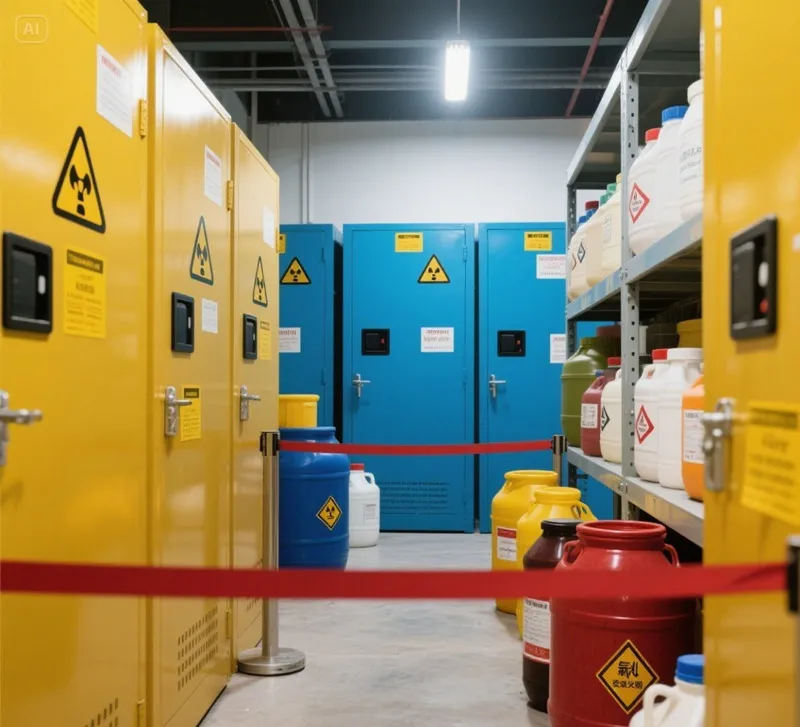Chemicals are essential to numerous industries, from manufacturing and research to healthcare and agriculture. However, many chemicals pose significant risks if not handled and stored properly. Safe chemical storage is not just a regulatory necessity; it's a fundamental aspect of protecting your employees, your facility, and the environment.

Why is Safe Chemical Storage So Critical?
● Protecting Lives: Improper chemical storage can lead to spills, leaks, fires, and explosions, causing serious injuries or fatalities. Prioritizing safety protects your workers and anyone who interacts with your facility.
● Environmental Responsibility: Chemical releases can contaminate soil, water sources, and air, resulting in costly environmental damage and potential legal ramifications. Responsible storage minimizes your environmental impact.
● Regulatory Compliance: Local, national, and international regulations govern the storage and handling of hazardous chemicals. Failing to comply can result in hefty fines, operational shutdowns, and reputational damage.
● Business Continuity: Accidents caused by improper storage can disrupt operations, damage equipment, and lead to prolonged downtime. Safe practices ensure the resilience of your business.
Key Principles of Safe Chemical Storage:
Implementing a robust chemical storage program involves a comprehensive approach. Here are some essential elements:
Segregation and Compatibility: Never store incompatible chemicals together. Consult a chemical compatibility chart to determine which substances react dangerously when mixed. Store acids separately from bases, oxidizers separately from flammables, etc.
Proper Container Selection: Use containers specifically designed for the chemical being stored. Ensure containers are made of materials that are compatible with the chemical and resistant to corrosion. Consider factors like pressure, temperature, and potential for degradation.
Clear Labeling: All containers must be clearly and accurately labeled with the chemical name, hazard warnings, and any necessary precautionary information. Follow Globally Harmonized System (GHS) standards for hazard pictograms and signal words.
Ventilation: Provide adequate ventilation in chemical storage areas to prevent the buildup of hazardous vapors. Consider installing local exhaust ventilation systems for particularly volatile chemicals.
Temperature Control: Many chemicals require specific temperature ranges for safe storage. Monitor and control the temperature of storage areas to prevent degradation, polymerization, or other undesirable reactions.
Spill Containment: Implement spill containment measures, such as spill pallets, berms, or diking, to prevent chemicals from spreading in the event of a leak or spill. Keep spill response equipment readily available.
Fire Protection: Chemical storage areas should be equipped with appropriate fire suppression systems, such as fire extinguishers, sprinkler systems, or foam suppression systems. Ensure that fire alarm systems are functional and regularly tested.
Security: Control access to chemical storage areas to prevent unauthorized entry and potential tampering. Implement security measures such as locks, fences, and surveillance cameras.
Training: Provide comprehensive training to all employees who handle or work near chemicals. Training should cover chemical hazards, safe handling procedures, emergency response protocols, and the proper use of personal protective equipment (PPE).
Regular Inspections: Conduct regular inspections of chemical storage areas to identify and correct any potential hazards. Inspect containers for leaks or damage, check ventilation systems, and ensure that spill containment measures are in place. Keep a log of these inspections.
Beyond the Basics: Additional Considerations
● Hazard Risk Assessments: Conduct thorough hazard risk assessments to identify potential risks associated with chemical storage and develop appropriate control measures.
● Safety Data Sheets (SDS): Ensure that SDSs are readily available for all chemicals stored on-site. SDSs provide critical information about chemical hazards, handling procedures, and emergency response.
● Waste Disposal: Implement a system for the safe disposal of chemical waste, following all applicable regulations.
● Working with a Specialist: Consider partnering with a company specializing in chemical safety to conduct audits, provide training, and offer expert advice.
Conclusion:
Safe chemical storage is an ongoing commitment that requires vigilance, planning, and training. By implementing the principles outlined in this article, you can significantly reduce the risks associated with hazardous chemicals and create a safer, healthier, and more compliant workplace. Prioritizing chemical safety is not just good for your business; it's the right thing to do.
